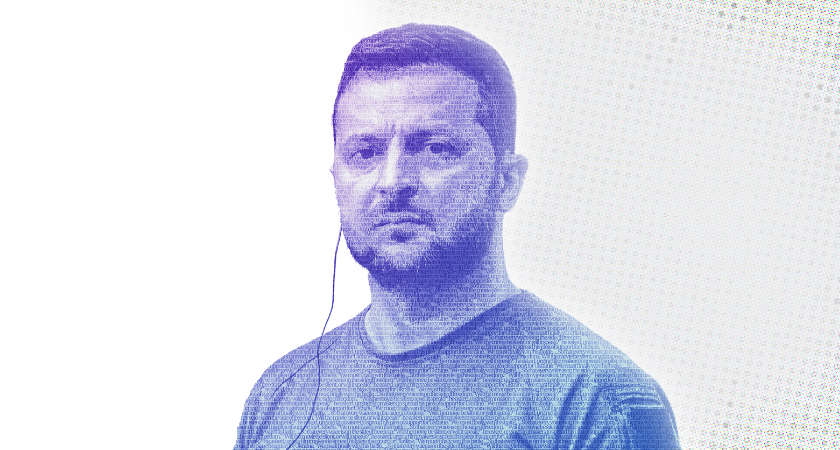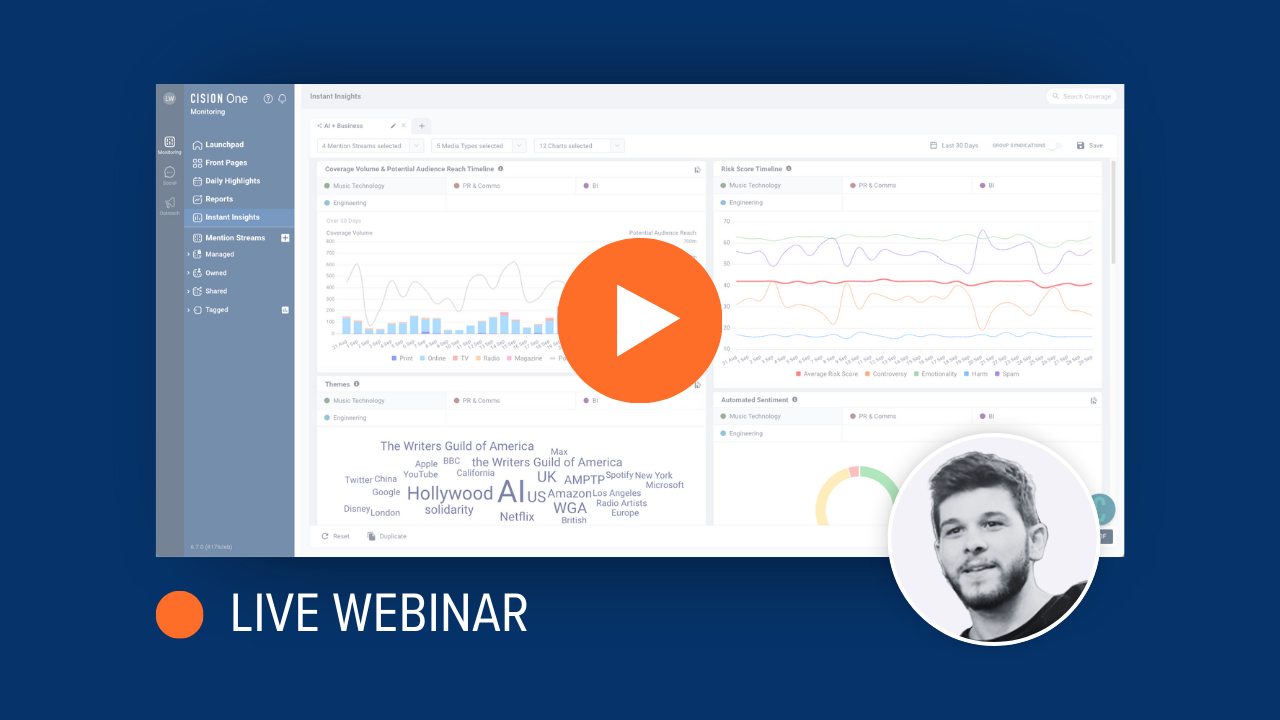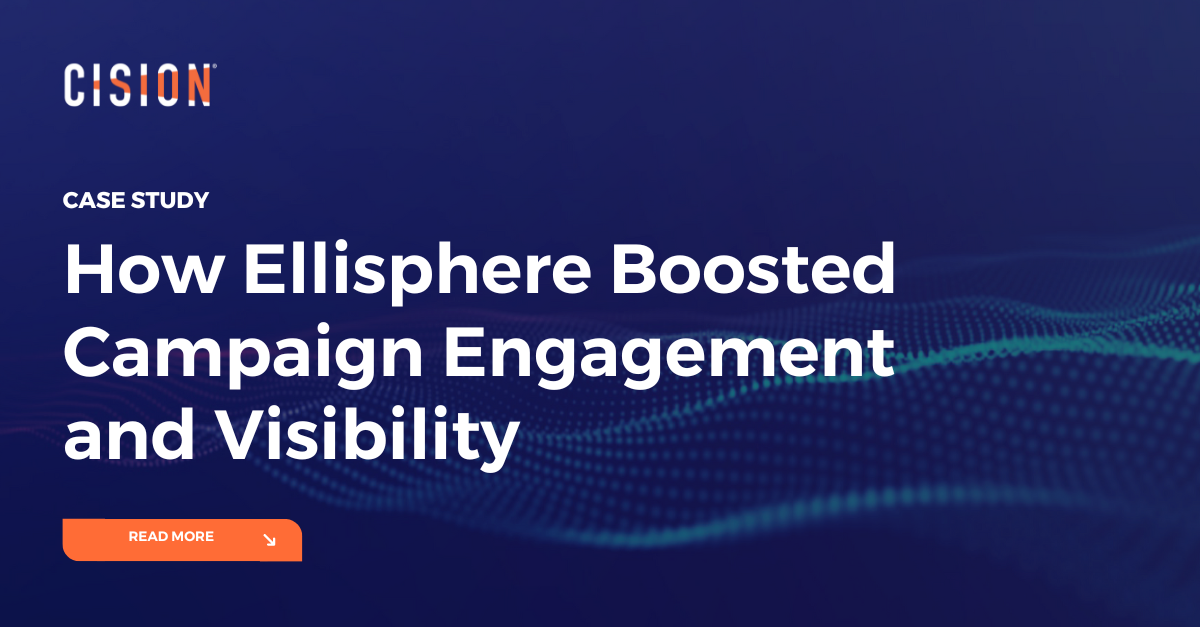 An abbreviated version of this article was previously published on PRNEWS
An abbreviated version of this article was previously published on PRNEWS
At Cision, I have the honour and privilege of helping shepherd communications during the most impactful moments for the biggest private sector organisations. One could debate that compared to what Volodymyr Zelenskyy and Ukraine are facing, those commercial efforts pale in comparison to the weight of communicating during a period of humanitarian crisis.
President Zelenskyy is widely acknowledged as a master of communication and the lessons below are gifts for us all as we, too, endeavor to own critical moments. That said, we hope we never lose sight of the daily struggle that’s been the result of the ongoing conflict and hope a peaceful resolution will come soon.
In a video speech delivered at the opening of this year’s Cannes Film Festival in May 2022, Ukrainian President Volodymyr Zelenskyy quoted a classic American movie: “I love the smell of napalm in the morning!” The famed line from 1979’s Apocalypse Now instantly grabbed the audience’s attention and made headlines. “Yes, it started in Ukraine in the morning,” Zelenskyy continued as he expertly tied together cinema and the devastating Russian invasion of his country that began on 24 Feb.. “Will the movie be silent, or will it speak?” he asked, urging filmmakers to spread his plea of support for Ukraine. “We must finally win this battle…. So that every voice is on the side of freedom.”
For President Zelenskyy, the stakes could not be higher: the protection of his people and homeland.
Though most will never be challenged in the way that Volodymyr Zelenskyy has been - war, displacement, trauma and economic crises - as a leader, he has been hailed as a skilled communicator. And he has been visible from the very start of the conflict, not shying away from difficult news or requests for help.
Leaders of nations - and corporations - have long studied The Art of War, the 2,500-year-old strategy treatise by General Sun Tzu. But for today’s Comms executives, there’s an equally compelling master to look to, right now: Volodymyr Zelenskyy.
President Zelenskyy is widely acknowledged as a master of communication and the lessons below are gifts for us all as we, too, endeavor to own critical moments.
The 44-year-old Ukrainian president is largely regarded as an exceptionally strong leader and authentic communicator, and he is generally seen as winning over hearts and minds around the world. He has done this by drawing on his storytelling skills - honed during his years as a producer, actor, and comedian. Zelenskyy and his government have created a narrative to advance their agenda that includes building an international coalition of support, securing funding and munitions, implementing a no-fly zone, and standing with the Ukrainian people who are fighting for their very right to exist as a nation.
Adding to his arsenal of comms tools, he has built relationships with strategic partners, pivoted as needed to respond to changing circumstances and he strives to keep his people informed, using personal touches and even humour to make emotional connections.
What follows are eights lessons communications professionals can learn from Zelenskyy’s masterful crisis management campaign for Ukraine.
Lesson 1: Lean in to Mythology
Before the internet and smartphones, there was storytelling. Humans have used language to share experience and wisdom for thousands of generations, and mythology has been used to explain the world around us and to communicate how a society could and should function.
Volodymyr Zelenskyy has absolutely capitalised on the power of mythology to galvanise his audience and see them amplify his messaging and support his political goals. As Pulitzer Prize–winning historian Anne Applebaum noted in an interview with Ezra Klein, Zelenskyy is “seen as somebody who is speaking for and defending a liberal society, one which is profoundly tolerant, in which people can speak more than one language, and they can have different religions, and they believe in freedom and the rule of law. And yet, he’s doing it with a military campaign, and in this vigorous and extremely brave way.”
In his case, it’s the appeal of liberalism that’s tapping something in the hearts and minds of citizens and politicians around the world.
For comms professionals managing a crisis, look for opportunities to speak to inherently human values that align with your brand; don’t shy away from making connections to universal and deeply human instincts and needs.
Lesson 2: Note the Power of Authentic Storytelling
Zelenskyy’s personal history itself is compelling. Born in the Ukrainian Soviet Socialist Republic, he grew up speaking Russian and earned a law degree before becoming a comedian and actor. He starred in 10 movies and even won the Ukrainian version of Dancing with the Stars. He was also a founding partner and producer of a sketch comedy ensemble called Studio Kvartal 95 and, in 2015, he produced and starred in the comedy series Servant of the People. In it, he plays a school history teacher who becomes the president of Ukraine after a viral video shows his character raging against corruption in the country.
Life imitated art when Zelenskyy decided to run for office in 2019. With his background in entertainment, he knew how to tell a story and use humour to make an impact. His visibility and wide social media reach helped him spread his campaign messages. As Orysia Lutsevych, a research fellow at the think tank Chatham House, told Vox Media, he “showed on the screen what kind of president he would be, and I think that was his basically campaign manifesto.”
Zelenskyy knows how to tell a powerful story and communicate with authenticity, especially in times of crisis.
The narrative of Zelenskyy’s life - his origin story - was a powerful component of his effective election messaging.
The outbreak of the conflict with Russia created a new opportunity for Zelenskyy to employ his mastery of language, and this time the impact of his message could mean life or death for his country. On 1 March, he delivered a powerful speech before the European Parliament. Using simple sentences he urged, “Without you, Ukraine will be alone. We have proven our strength. Prove that you will not leave us behind…. We are fighting, just for our land. And for our freedom.”
His message was so emotional (see Lesson 8) that even the translator choked up. In that moment, it became clear to the European Union that Ukraine’s battle for existence potentially had consequences far beyond that country’s borders - and that the EU needed to join Ukraine’s fight against tyranny. His message to Europe has made it “morally and politically impossible for them to stay on the sidelines,” said Time magazine reporter Simon Shuster.
Zelenskyy knows how to tell a powerful story and communicate with authenticity, especially in times of crisis.
Lesson 3: Be Agile
Zelenskyy also knows how to pivot when needed and how to capitalise on an unexpected moment. While running for office, there were many skeptics who thought the political neophyte was a lightweight. But his familiar face and a newly serious mien helped him win 73% of the vote, securing the presidency.
As written in The Guardian in April 2019, “At the press conference following the latest vote, he seemed to have dropped the punchlines completely. ‘All I care about is the people. Not politics. Not ambition. The people are what matter.’” Speaking clearly and concisely Zelenskyy delivered his message. And his audience bought in - and put him in office.
There was a time when his presidency declined in popularity. Some worried he was “slipping towards the usual way of doing business in Ukraine,” says Chatham House’s Lutsevych. When Zelenskyy initially downplayed the growing Russian forces on the Ukrainian border, he began to lose traction as a leader.
But soon after the invasion, Zelenskyy recorded a video on the streets of Kyiv with members of his administration, wearing what has become his trademark olive-green T-shirt. He insisted they were not abandoning the capital. His message instantly restored the country’s faith in him. And his reputation around the world began to grow as a wartime president.
Zelenskyy knows how to take a moment in time and work it to its full potential. One cannot plan for everything, but being aware of shifts in circumstances or sentiment allows for on-the-spot pivoting.
In another example, when his famous statement: “I need ammunition, not a ride” (see Lesson 8 below) gained traction and attention, he followed it up the next morning by posting a heartfelt, less glib video statement on YouTube: “I’m here. We won’t lay down arms. We will defend our country because our arms are our truth. Our truth is that it’s our land, our country, our children, and we will defend all of this.…Glory to Ukraine.”
Zelenskyy saw immediately that his clever response to an offer for an airlift to safer ground was a moment to capitalise on, and he added a more somber and serious exclamation point to it with his video.
He knows how to take a moment in time and work it to its full potential. One cannot plan for everything, but being aware of shifts in circumstances or sentiment allows for on-the-spot pivoting.
Lesson 4: Follow the Marketing Rule of 7 - and Follow the Data
The Rule of 7 states that any time you have to communicate with a large group of people, they must hear or see a message at least seven times before they’ll be provoked to take action. Zelenskyy has used this repetitive message strategy ever since he ran for office.
As the European Council on Foreign Relations reported in 2019, “Zelenskyy was easily the most visible candidate on Facebook, Instagram, Telegram and - with his comedy videos and vlogs - YouTube. ‘ZeBots’ left his logo everywhere. Online volunteers, ‘Ze Lyudy’ (‘Ze People’), tweeted and messaged their support.” By following this rule of repetition and cultivating partnerships with like-minded advocates who will help to spread one’s messages, PR professionals can not only grow an audience, but also build relationships.
By following this rule of repetition and cultivating partnerships with like-minded advocates who will help to spread one’s messages, PR professionals can not only grow an audience, but also build relationships.
When Vladimir Putin invaded Ukraine on 24 February, Zelenskyy immediately began to shape and repeat his complex message: He needed to rebuff the Russian invasion; solidify strong relationships with other world leaders - particularly in the West; show his people that he was working to get them the support Ukraine needs; and restore peace.
A prolific Twitter user (@ZelenskyyUA), Zelenskyy continues to use his office’s social media channels to promote his messages and has repeatedly employed the hashtags #StrongerTogether and #EmbraceUkraine in many of his Tweets.
Study your analytics, know which trending topics are important to your business and publish your messaging multiple times on multiple channels, as social media - especially for global brands - is a 24-hour channel, and the audiences that matter to you may not be exposed to your messaging the first time it’s broadcast.
Fundamentally critical in times of crisis, look to the data to guide your communications. Stay on top of trending stories by leveraging tools for media monitoring, sentiment analysis and social listening. They’ll position you to pick up on changes in external narratives.
And use all of your channels. It’s important to be out front, owning your story.
Lesson 5: Know Your Stakeholders and Meet Them Where They Are
Zelenskyy’s “customers” include, essentially, the entire world, even Russians. And public relations and communication professionals may be encouraged to shape their communications for the broadest possible audience.
In his victory speech after being elected in 2019, Zelenskyy said, “A European country starts with everyone…. We have to be united, and only then are we strong.” As summed up by Chatham House’s Lutsevych, “he is saying, ‘I am the hope for change, not just for people in Ukraine, but for all people,’ likely hinting at Russia.” Note how his message was all-inclusive.
But he knows he is also speaking to at least two distinct audiences: Western leaders who have the means to provide financing and arms to Ukraine, and to his own people, who need to feel supported and protected by their government. Zelenskyy walks a fine line of addressing both constituencies, sometimes in the same speech or social media post, and you can witness his careful wording in action.
When aiming his message at President Biden and other international leaders, he mentions “Strategic Partnerships.” Frequently, he tweets not only in Ukrainian, but also in English, Slovak, Polish and Georgian, so his messages are tailor-made for whomever he’s trying to influence.
His strategy gets results. Following the speech he gave to the American Congress on 16 March, President Joe Biden announced an additional $800 million in military assistance to Ukraine.
When speaking to his people, he keeps an open line of communication. He may post more than 20 times a day, informing his citizens of diplomatic progress: “Talked to @JustinTrudeau. Thanked him for the leadership in imposing anti-Russian sanctions…” he tweeted on March 2 in a typical post.
His simple language, often using words like “solidarity,” “resilience,” and “peace” speaks to all levels of Ukrainian and global society. On 23 July, he wrote on Twitter, “Thank you @POTUS for the new defense aid package for Ukraine. Critically important, powerful arms will save our soldiers’ lives, speed up the liberation of our land from the Russian aggressor. I appreciate the strategic friendship between our nations. Together to victory!”
Use inclusive language when you want to connect with the largest audiences possible, and sometimes it is best to toss the jargon and get right to the point.
Lesson 6: Be Available
Especially at the start of the war, Zelenskyy seemed to be everywhere: on YouTube, on Twitter and in interviews for global media. He gave speeches to the U.S. Congress, the European and British Parliament and more. He even had a Zoom call with American celebrities Ashton Kutcher and Mila Kunis, thanking them for raising funds for Ukrainian refugees - and he tweeted about it.
Zelenskyy’s untiring willingness to be visible as he asks for aid and support is important for messaging in our world of split-second news briefs and social media moments.
Zelenskyy’s untiring willingness to be visible as he asks for aid and support is important for messaging in our world of split-second news briefs and social media moments.
Part of being available is also being relatable. During the war, Zelenskyy has continued to demonstrate his accessibility to his strategic partners and fellow Ukrainians. He even changed his visual presentation, shedding his blue business suits for olive-green T-shirts or military-style jackets, which he’s worn even in appearances before the American Congress and other Western governmental bodies.
His wardrobe change was a message conveyed to everyone, civilians and military alike, that he had become a wartime president, but also that he was getting down to work in the trenches, alongside his people. “The T-shirt is a reminder of Mr. Zelenskyy’s origins as a regular guy,” wrote the New York Times. It “is as clear a statement of solidarity with his people as any of his rhetoric.”
Know when to speak to your stakeholders as equals: acknowledge who they are and what they believe. Sometimes it’s best to put on your proverbial uniform and look your audience directly in the eye.
Lesson 7: Use Data to Measure Effectiveness
Ever since he announced he was running for the presidency of Ukraine, Zelenskyy has been a believer in what’s known as “e-government,” or electronic government. The Organization of American States defines e-government as “the application of Information and Communication Technologies (ICTs) to government functions and procedures with the purpose of increasing efficiency, transparency and citizen participation.”
A media veteran, Zelenskyy knows how to use data. As a political candidate, he employed crowdsourcing, using YouTube to ask potential voters to “submit the five main problems they see in Ukraine,” as a way to collect information to help him shape his campaign messaging. As of July 2022, he had 16.9 million Instagram followers, 6.4 million followers on Twitter and over 3 million connections on Facebook, giving him the audience reach of just shy of the population of Texas.
On 3 April, for example, he was able to amplify his own reach by making a video speech at the Grammy Awards, which brought in a viewership of 9.6 million. He knows that big numbers bring big results.
President Zelenskyy understands how to maximise his various audiences and drive engagement with his content beyond his own accounts - and speaking at major media events are one of the options in his communications toolkit.
President Zelenskyy understands how to maximise his various audiences and drive engagement with his content beyond his own accounts - and speaking at major media events are one of the options in his communications toolkit.
And don’t forget that listening can be as vital as speaking. Invite feedback, listen to customers and competitors, and make it easy for customers and stakeholders to reach out to you. One cannot serve if they do not listen.
Lesson 8: Make Emotional Connections
Not only have Zelenskyy’s messages been emotional and authentic (see Lesson 2), they have at times been humorous - not surprising for a one-time comedian. He recognises that lightness adds a personal touch that aids in making an emotional connection with a target audience.
In March, Zelenskyy said, “You know, we used to say, ‘Monday is a hard day.’” He paused for a beat, then added, “There is a war in this country, so every day is Monday.” The war’s brutality and death toll are no joke, obviously, but his simple, exhausted-yet-funny statement grabs people’s attention. It also puts the magnitude of Ukraine’s trauma and Zelenskyy’s experience as a wartime president - the work never stops! - into accessible terms. He’s saying, “You think your Monday is bad? Look at ours.” Once he has gotten people to recognise this truth, he can make his stronger, more necessary and serious points.
Zelenskyy has employed this tactic since the onset of the war. The day after the invasion, the AP reported that he turned down an offer of help from the U.S. government for him and his family to evacuate from Kyiv by saying, “The fight is here; I need ammunition, not a ride.” That statement rocketed around the world and made its way into newspaper headlines - and all over Twitter. It is another statement that’s sardonic and funny - and a powerful acknowledgement of his situation.
As noted by Susan J. Wolfson in The Atlantic, who argues the Ukrainian president is “the genuine Byronic hero for our times,” the statement was “even printed on Zelenskyy-style olive-green T-shirts.” One day into the war, Zelenskyy had gone viral.
By watching and learning from the world leader some have compared to Winston Churchill, professional communicators might succeed just as brilliantly - especially in times of crisis. Going back to the basics should be part of every communicator’s strategy: focusing on your story, being authentic, pivoting when needed, staying visible, knowing your audience, having a broad portfolio of media channels, analysing your data and being cognizant of the power of connecting on an emotional, human level.
Going back to the basics should be part of every communicator’s strategy: focusing on your story, being authentic, pivoting when needed, staying visible, knowing your audience, having a broad portfolio of media channels, analysing your data and being cognizant of the power of connecting on an emotional, human level.
To learn more about how Cision is helping brands and brand professionals employ these lessons to refine their communications strategies, speak with one of our experts.
Most Recent Posts
Cision Resources
-
E-books and Guides
Comprehensive how-to guides on strategy and tactics
-
Case Studies
What are other brands doing – and how can we learn from them?
Learn More. Do More. demo new
PR Tips, Case Studies, and Product Updates

[On-Demand Webinar] The Next Generation of Media Intelligence: From Gorkana to CisionOne
Explore CisionOne, a revolutionary media intelligence platform, and the evolution of Gorkana. Learn key features and strategies from Luke Williams, CisionOne Product Marketing Manager. Elevate your media outreach to new heights!

